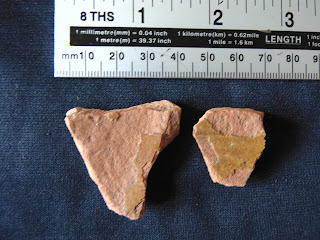On our local pasture permission some good finds have been emerging , and here are a couple from this week.
The first emerged from about 4" down, after giving a faint but consistent pip on the C-scope 3. He is a little lead soldier, which is apposite, as little lead soldiers happen to be my other main hobby.
I would guess this chap is late 19c, depicting a cavalry man of the time, or possibly earlier in the century. His head and the horses legs and tail were missing , and the horses head bent right back. He is of a style known as a semi-flat, so almost 2 dimensional but not quite. We are starting to think the field in which he was found was a popular picnic destination in the 18th and 19th centuries. It is just far enough out of town to be a pleasant walk there and back, making a day of it, and stopping for a picnic in our field which has a lovely view of the valley below. Coins from the reigns of George II, III, William IV and Victoria have surfaced, along with an eighteenth century love token and late 19c silver matchbox and teaspoon (I will post these finds in the future). This little soldier may have dropped by some young lad on such an excursion.
One of the great things about this hobby is placing a possible story to the finds. How or why did they end up in the ground?
The next artefact (in the metal detecting world a coin is a coin, and anything else is an artefact), needs little explaining, but was equally interesting and perhaps a little alarming. This gave a strident signal, and digging down about 6" I pulled out the case first and was somewhat taken aback to see it was still filled with propellant (explosive) just visible at the damaged end as a grey black granular substance. The bullet came next and it still appears to be coated in red tracer paint, which would have burned white hot when the bullet was fired. So perhaps this was a misfire ejected from the gun of an aircraft overhead. I think the bullet is from an Allied aircraft, and the groove at the base of the case indicates it was from a belt fed machine gun. I will be doing more research, but perhaps the bullet was fired during the Baedecker Raids on Bath on 25-27th April 1942 by aircraft or anti-aircraft guns trying to defend the city?










%20Web-500x500.jpg)
